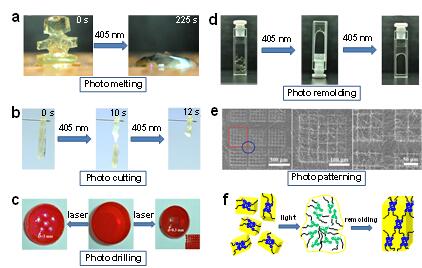With the development of intelligent materials, the magical fantasy about the autobots in the cartoon "Transformers" is becoming closer and closer to scientific reality. Polymer networks based on reversible dynamic covalent crosslinking can respond to external stimuli such as thermal, light, mechanical and chemical stimuli, and achieve remoldability, recycling, and environmental adaptability. At present, most researchers focus on the manufacture of dynamic flexible materials with optical response, as light has great spatiotemporal precision. Via modifying polymers with various types of photochromic structures, only a few studies have been reported on gels with the capacities of solid-liquid conversion and self-healing. However, due to the limitations of existing photochromic molecular structures and polymer systems, present photo- remodelable polymers usually meet the problems of complex synthetic procedures, low reaction efficiency, weak mechanical toughness, and also single functions, which limit their practical applications.

Figure 1. The molecular mechanism of deformation and remolding of PTA-HABI gel.

Figure 2. Photoplastic processing based on PTA-HABI gels. (a) Photo melting. (b) Photo cutting. (c) Photo drilling. (d) Photo remolding. (e) Photo patterning. (f) Proposed mechanism of photoplastic transformation of PTA-HABI gel.
Herein, Pro. Zhu's group in Huazhong University of Science and Technology have prepared a kind of smart gel PTA-HABI with high responsibility on visible light by introducing the photochromic hexaarylbiimidazole (HABI) units into the polytriazole (PTA) networks based on the typically Click reaction (Figure 1).HABI undergoes photo-induced cleavage of C-N bond of two triphenylimidazoles upon light irradiation to give a pair of isolated triphenylimidozole radicals (TPIRs) and can rapidly recombine back into HABI spontaneously, which acts as the reversible covalent crosslinked points.
The PTA-HABI gel has the capacity of sol-gel transformation responding on light irradiation. Upon 405 nm irradiation, the initial macroscopic morphology of the materials is completely transformed into another morphology (Figure 2a), just like the “transformer”. Utilizing this property, PTA-HABI can be used as the processable photoplastic materials for photo cutting (Figure 2b), photo drilling (Figure 2c), photo remolding (Figure 2d), photo patterning (Figure 2e), and so on. Moreover, Zhu et al. prepared the elastomers of PTA-HABI and PTA-HABI-TPE (dry gels) with reversible covalent crosslinked networks of HABI. They exhibit excellent self-healing ability and the special properties of reversible photoplastic elongation and contraction.
Dynamic covalent crosslinked networks based on HABI are highly sensitive to light irradiation and could be applied to different smart flexible materials and devices such as flexible robots, wearable devices and biomedical engineering. Due to the simple preparation methods and excellent performance, HABI based gels are promisingly applied in the field of intelligent flexible devices.
This work is published in ACS Applied Materials & Interfaces (Photoplastic Transformation Based on Dynamic Covalent Chemistry, ACS Appl. Mater. Interfaces 2019, 11, 23623-23631. This work was supported by the National Science Foundation of China, the National Basic Research Program (973) of China and the Fundamental Research Funds for the Central Universities. Shi-Li Xiang and Dr. Qiong-Xin Hua are the first coauthors; Prof. Ming-Qiang Zhu, Dr. Chong Li and Prof. Gary J. Cheng are the corresponding authors.
Full text is available at https://pubs.acs.org/doi/10.1021/acsami.9b06608